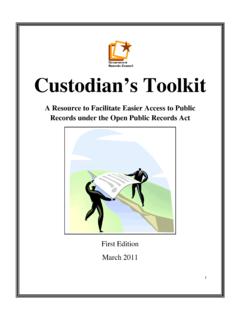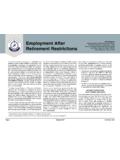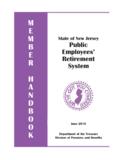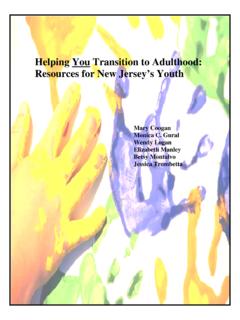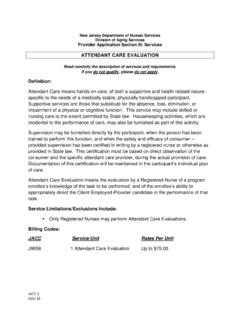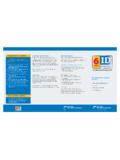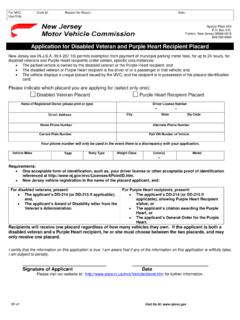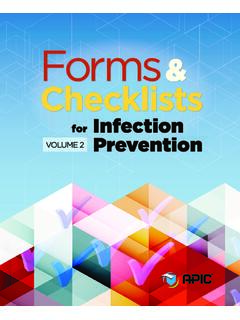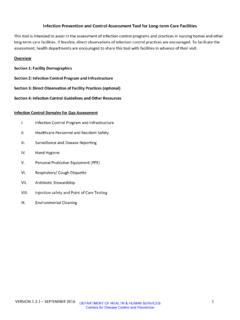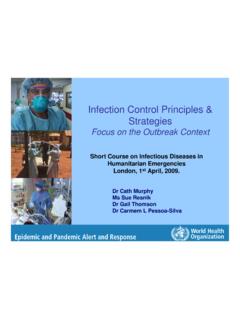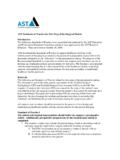Transcription of Recommendations for Long-Term Care Facilities during …
1 Recommendations for Long-Term Care Facilities during COVID-19 Pandemic November 10, 2020 Page 1 of 6 The New Jersey Department of Health (NJDOH) has developed this guidance to assist long term and residential care Facilities in response to the COVID-19 pandemic. Given the congregate nature of Long-Term care Facilities (LTCF) and residents served ( , older adults often with underlying chronic medical conditions), this population is at an increased risk of serious illness when infected with COVID-19. LTCF have experience managing respiratory infections, including the previous surge of COVID-19, and outbreaks among residents and healthcare personnel (HCP1) and should apply those outbreak management principles, in addition to heightened measures within.
2 Please note this is a rapidly evolving situation and as more data become available this guidance may change. Additional resources on how LTCF can prepare for and manage COVID-19 can be found at Highlight reflects content revisions. Identify plan and resources Review and update your CMS all-hazards emergency preparedness program and plan which includes emergent infectious diseases. If you do not have a plan , a template can be found at Review CDC s COVID-19 Preparedness Checklist for Nursing Homes and other LTCF at Review the Occupational Safety and Health Administration (OSHA) Emergency Preparedness and Response page at Identify public health and professional resources.
3 Locate a local health department (LHD) contact using the NJDOH Local Public Health Directory at Contact NJDOH at or via phone during regular business hours at (609) 826-5964 for questions, and after hours/weekends at (609) 392-2020 for emergencies. Connect with state Long-Term care professional/trade association resources. Assign one person to monitor public health updates from federal, local, and state entities. Identify contacts at local hospitals in preparation for the potential need to hospitalize facility residents or to receive discharged patients from the hospital.
4 If a resident is referred to a hospital, coordinate transport with the hospital, LHD, and medical transport service/emergency medical service to ensure that the resident can be safely transported and received by the facility. Opening and/or maintaining bed capacity in hospitals is vitally important. A list of New Jersey state hospitals can be found at Protecting residents, visitors, and HCP Provide education about respiratory infections, including COVID-19. Educate on potential harm from respiratory illnesses to nursing home residents, and basic prevention and control measures for respiratory infections such as influenza and COVID-19.
5 Include the following topics in education: o Hand hygiene: o Respiratory hygiene and cough etiquette: o Personal Protective Equipment (PPE): November 10, 2020 Page 2 of 6 o Flu season: CDC COVID-19 Print Resources: Develop criteria and protocols for screening and/or restricting entrance to the facility. Ill individuals are the most likely sources of introduction of COVID-19 into a facility. CDC recommends aggressive screening and enforcing sick leave policies for ill HCP. Individuals ( , vendors, visitors, essential caregivers) should be screened for fever and other symptoms of COVID-192.
6 Those with symptoms or unable to demonstrate proper infection control techniques should not be permitted to enter or stay at the facility. Any individuals that are permitted and screened should practice source control , social distancing, perform frequent hand hygiene, and restrict their visit to a designated area. Use of a facemask for source control is recommended for HCP if not otherwise wearing a respirator. Facilities located in areas with moderate to substantial community transmission are more likely to encounter asymptomatic or pre-symptomatic individuals with COVID-19 incubation or infection.
7 Community transmission levels can be assessed by referring to the NJDOH COVID-19 Activity Level Index (CALI) Score at Universal eye protection in addition to source control and other infection prevention and control measures, should be instituted to ensure the eyes, nose, and mouth are all protected from exposure to respiratory secretions, for all HCP and for all individuals who are unable to maintain social distancing. Advise any persons who entered the facility to monitor for fever and other COVID-19 symptoms2 for at least 14 days after exiting the facility.
8 If symptoms occur advise them to self-isolate at home, contact their healthcare provider, and immediately notify the facility of the date they were in the facility, the persons they were in contact with, and the locations within the facility they visited. Review, implement, and reinforce an infection control plan for preventing communicable disease among residents, visitors, and HCP. The plan should include: Transparent communication to staff and families regarding identification of a COVID-19 outbreak or investigation and actions taken. o Communicate with families to advise them of visitor restrictions and alternative methods for visitation ( , video conferencing) during an outbreak.
9 A sample communication letter can be found at o Consider creating list serve communication to update families, assigning staff as primary contacts for families for inbound calls and conducting regular outbound calls to keep families up-to-date, offering a phone line with a voice recording updated at set times each day with the Facilities general operating. Enact a policy defining what PPE should be used by visitors and essential caregivers. Before visitors enter the designated area, staff will provide instructions to visitors on hand hygiene, limiting surfaces touched, and appropriate use of PPE.
10 Designated visitation areas should be cleaned and disinfected after each visit. Ensure visitor movement is limited within the facility ( , avoid the cafeteria and other gathering areas). Review the CMS Quality, Safety & Oversight (QSO) Group memo Ref: QSO-20-39-NH at and the NJDOH COVID-19 Temporary Operational Waivers and Guidelines at for expanded Recommendations . A policy for when HCP should use Standard, Droplet, and Contact Precautions for residents with symptoms of respiratory infection unless the suspected diagnosis requires Airborne Precautions ( , tuberculosis).
